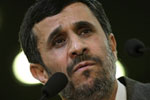 Wall Street Journal: Iran’s parliament revealed it planned to impeach President Mahmoud Ahmadinejad but refrained under orders from Supreme Leader Ayatollah Ali Khamenei, exposing a deepening division within the regime.
Wall Street Journal: Iran’s parliament revealed it planned to impeach President Mahmoud Ahmadinejad but refrained under orders from Supreme Leader Ayatollah Ali Khamenei, exposing a deepening division within the regime.
The Wall Street Journal
By FARNAZ FASSIHI
 Iran’s parliament revealed it planned to impeach President Mahmoud Ahmadinejad but refrained under orders from Supreme Leader Ayatollah Ali Khamenei, exposing a deepening division within the regime.
Iran’s parliament revealed it planned to impeach President Mahmoud Ahmadinejad but refrained under orders from Supreme Leader Ayatollah Ali Khamenei, exposing a deepening division within the regime.
Lawmakers also launched a new petition to bring a debate on the president’s impeachment, conservative newspapers reported Monday.
The reports of challenges to Mr. Ahmadinejad were intended as retorts to a powerful body of clerics that urged Mr. Khamenei to curb the parliament’s authority and give greater clout to the president.
In a report released Sunday and discussed in parliament Monday, four prominent lawmakers laid out the most extensive public criticism of Mr. Ahmadinejad to date.
They accused him and his government of 14 counts of violating the law, often by acting without the approval of the legislature. Charges include illegally importing gasoline and oil, failing to provide budgetary transparency and withdrawing millions of dollars from Iran’s foreign reserve fund without getting parliament’s approval.
“The president and his cabinet must be held accountable in front of the parliament,” the report stated. “A lack of transparency and the accumulation of legal violations by the government is harming the regime.”
The moves against Mr. Ahmadinejad come as the regime faces domestic pressure over his plans to gradually eliminate subsidies for fuel, food and utilities from an economy strained by a string of international sanctions over Tehran’s controversial nuclear program.
Authorities have tightened security and arrested members of the opposition to prevent riots and uprisings in response to the subsidy cuts, which economists say will drive up inflation.
In opposition to the conservative lawmakers are Iran’s ultraconservatives—led by Mr. Khamenei, who has final say in all state matters—who have increasingly backed the president when he carries out policy without parliamentary approval.
Mr. Ahmadinejad hails from this ultraconservative camp, which has largely supported populist economic policies and taken a defiant stance abroad, as opposed to mainstream conservatives’ more pragmatic approach.
Conservative newspapers reported on Monday that lawmakers have started a motion to collect the 74 signatures needed to openly debate impeachment. Mousa Reza Servati, the head of the parliament’s budgetary committee, was quoted as saying 40 lawmakers, including Mr. Servati, have signed the motion.
The move to remove the president from office marks the first time in the history of the Islamic Republic that parliament has discussed impeachment of a president. Though the legislature is backed by the Iranian constitution, lawmakers can’t drive Mr. Ahmadinejad from office without the supreme leader’s agreement.
One issue on which both camps are broadly united is in supporting Iran’s right to proceed with its nuclear program against the objections of the international community.
Mr. Ahmadinejad is likely to continue positioning himself on the international stage as the defiant voice of Iran’s leadership as Tehran eyes a new round of nuclear talks, proposed for Dec. 5.
The conservative camp also closed ranks behind Mr. Ahmadinejad after the turbulent 2009 presidential election and its violent aftermath—setting aside differences to support the regime. But a considerable portion of highly influential members of the conservative bloc, such as speaker of the parliament Ali Larijani, appear to have begun to view Mr. Ahmadinejad as a liability.
U.S. officials on Monday said they’re watching the political clashes in Tehran and believe they’ve fueled, in part, by sanctions imposed by Washington, the United Nations and the European Union since June. The Obama administration has hoped that these tensions could lead Tehran to return to negotiation aimed at containing its nuclear program, something, so far, it hasn’t decided to do.
“There are clear rivalries within the Iranian government and multiple camps around Ahmadinejad, Larijani and others,” said State Department spokesman P.J. Crowley. “Those tensions have certainly been exacerbated as Iran feels more pressure from sanctions and political isolation.”
Still, because rival political forces inside Iran, particularly those concentrated around Mr. Larijani, are also supportive of Iran’s nuclear work, is unclear how much Iran’s foreign policy would change if Mr. Ahmadinejad exits the scene, U.S. officials said.
On websites and blogs, the primary outlet for Iran’s opposition, Iranians urged parliament not to give in to Mr. Khamenei’s orders and, as one blogger wrote, “act independently for the good of the public.”
On Saturday, the Guardian Council, the appointed body of ultraconservative clerics that oversees legislation and acts as a mediator between the government and the parliament, said a “mediating committee” that included council members recommended Mr. Khamenei curb the powers of the parliament.
The remarks infuriated lawmakers, who said they had made no such recommendation, leading to a heated open debate on the parliament floor on Monday.
Some of Mr. Ahmadinejad’s alleged violations included withdrawing $590 million from the Central Bank’s foreign reserve fund, trading 76.5 million barrels of crude oil in exchange for importing gasoline in 2008, and illegal imports of gasoline, oil and natural gas since 2007 at a value of about $9 billion.
Mr. Ahmadinejad has had an uneasy relationship with parliament since his election in 2006, but the differences escalated in his second term, when lawmakers refused to approve eight of his cabinet nominees.
Mr. Khamenei intervened, asking parliament members to compromise. In the end only three cabinet choices were refused. The parliament also fought Mr. Ahmadinejad for a year over his economic plan and the subsidy cuts. Mr. Ahmadinejad finally wrote a letter to Mr. Khamenei complaining that the parliament was acting as an obstacle for his administration.
—Jay Solomon contributed to this article.


